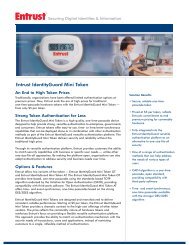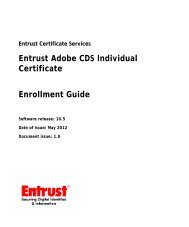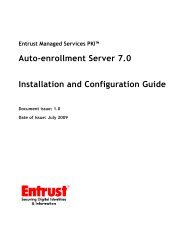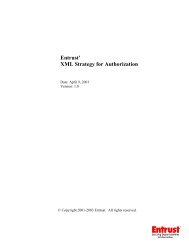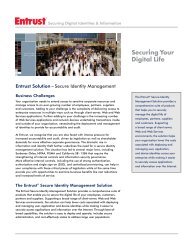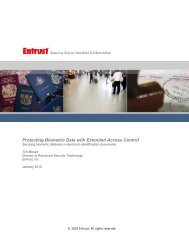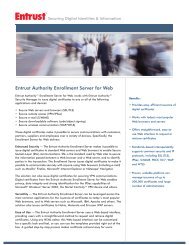X.509 Certification Path Validation - Entrust
X.509 Certification Path Validation - Entrust
X.509 Certification Path Validation - Entrust
You also want an ePaper? Increase the reach of your titles
YUMPU automatically turns print PDFs into web optimized ePapers that Google loves.
<strong>X.509</strong> certification path validation Conformance<br />
4. CONFORMANCE<br />
<strong>Path</strong> validation is a critical element of protecting the interests of relying parties and ensuring that relying<br />
parties use only certificates that comply with the security policy of their local PA as well as that of all PAs<br />
of domains represented in the certification path. In addition to ensuring that relying party path validation<br />
systems being deployed satisfy the functional requirements of the local domain, another critical factor is<br />
ensuring that the systems being deployed are actually performing these processes in compliance with the<br />
definitions for path validation standardized in [<strong>X.509</strong>] and [PKIX]. The path validation process is a<br />
relatively complex process and until recently there has not been a comprehensive test suite available to<br />
assess conformance. In 2003 the National Institute of Standards and Technology (NIST), together with<br />
the National Security Agency (NSA) and DigitalNet, produced a test suite that tests path validation<br />
implementations to ensure that they perform elements of path validation in conformance with those base<br />
standards. The test suite, known as Public Key Interoperability Test Suite (PKITS) provides test<br />
descriptions as well as test data for all aspects of certification path validation. NIST has also produced a<br />
set of PKI client protection profiles that group together functional sets of path validation checks.<br />
The basic profile includes all path structure and certificate validity checks described in 3.2.1 and 3.2.2 of<br />
this paper as well as a small number of business control checks described in 3.2.3.<br />
The bridge-enabled profile adds requirements to support the process constraints and most of the<br />
infrastructure constraints described in 3.2.3.<br />
Other profiles focus on enhanced CRL processing.<br />
Each functional area specifies the set of tests that a relying party path validation system must pass. The<br />
PKITS test suite has been thoroughly reviewed by <strong>X.509</strong> and [PKIX] experts and some vendors have<br />
already performed many of these tests privately as part of the review of the test suite. After a full year of<br />
review and scrutiny the PKITS test suite is now very stable and can be considered the definitive<br />
interpretation of the base standards. It is anticipated that within the early part of 2004 necessary<br />
approvals of both the test suite and the client protection profiles will be obtained and formal test<br />
laboratories will be established to perform independent testing against the PKITS test suite and<br />
accreditation of path validation implementations to specific protection profiles. Given the increasing<br />
popularity of the bridge trust model, the protection profile that enables implementations to claim they are<br />
“bridge-enabled” is expected to be particularly important, especially in government deployments.<br />
© Copyright 2004 <strong>Entrust</strong>. www.entrust.com<br />
All rights reserved. Page 12



